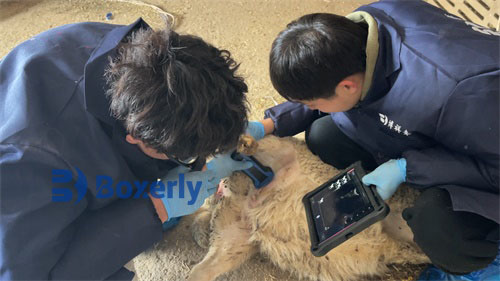The staff who operate the B-ultrasound machine for cows must first learn how to perform rectal examination. Only personnel with a foundation in rectal examination and certain practical experience can master this precision instrument. Rectal examination is a collaboration between humans and cows, while the operation of cows using ultrasound machines is a mutual coordination between cows, humans, and cows using ultrasound machines. The specific steps are as follows:
1. Understand the general reproductive status of cows and consult calving and mating records. Adult cows should have a mating period of more than 30 days, and young cows should have a mating period of more than 25 days before undergoing B-ultrasound examination (* * * It is recommended to uniformly set it to 30 days after mating).
2. Firstly, follow the general principles of bovine rectal examination. It is required to stand and hold the cows in the cowshed, whether in the passage, cowshed with neck shackles, or milking parlor. For the safety of people and equipment, appropriate holding should be done for the cows, and if necessary, ropes or kick bars should be used to hold the hind limbs of the cows. Try to remove the fecal matter from the cow's rectum as much as possible to avoid it from affecting the ultrasound probe
Scanning imaging causes adverse effects. After inserting some coupling agent into the condom, protect the probe to ensure its service life. At the same time as cleaning the fecal matter in the rectum, the position of the uterine horn and ovaries in the pelvic cavity should be touched clearly to preliminarily determine the position of the ultrasound probe to be placed.
3. When touching the position of the uterine horn and ovaries, it is necessary to understand the developmental changes of both sides of the uterine horn and ovaries, preliminarily determine which side of the uterine horn has changed or the ovaries are fuller, and determine which side of the uterine horn the ultrasound probe should be placed on. After the B-ultrasound probe enters the rectum, it is placed on the side of the uterine horn to be explored (the small or large curvature of the uterine horn), and then scanned to obtain the image judgment result. Fixed egg
During nest examination, if the squeezing force is too strong, the follicles on the ovary may rupture or the diameter of the corpus luteum may increase after being squeezed, which affects the interpretation of ovarian morphological indicators.
4. When conducting pregnancy diagnosis, it is necessary to comprehensively explore the uterus and perform ovarian examination if necessary. When the bladder is filled with urine, it can be checked after urination. If examination is necessary at this time, the cervix can be pulled back into the pelvic cavity, and the probe can be placed on the uterus for exploration or a lateral exploration of the uterus can be performed. Note that within 28 days after mating, if only uterine dilation is seen and the fetus cannot be found, only surgery can be performed
A preliminary pregnancy diagnosis has been made and requires a re examination. Due to the high early mortality and miscarriage rates of embryos within 60 days after mating, those diagnosed as pregnant by B-ultrasound examination within 60 days need to undergo rectal examination 2.5-3 months after mating for confirmation.
5. When repeatedly examining the same cow, whether it is a rectal examination or an ultrasound examination, a single use plastic long arm glove should be lubricated with paraffin oil each time. When removing cow manure, hands should be used to remove it from different sides, top, and bottom of the rectum to minimize stimulation and mucosal damage to the cow's rectum. Otherwise, it is not possible to examine the same cow continuously every day.








